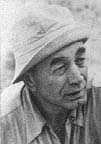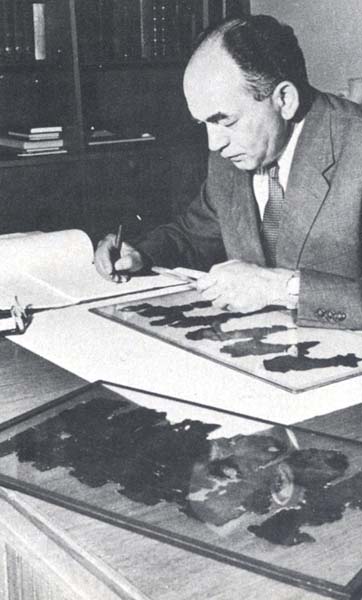Nahman Avigad: In Memoriam
046

Nahman Avigad was born in the Galician town of Zawalow (then in Austria, now in the Ukraine), on September 25, 1905, the son of Isak and Perl Reiss. He died at age 86 in Jerusalem on January 28, 1992. His childhood and schooling took place in Brno, Czechoslovakia, where his family had moved, and he completed his undergraduate training at the University of Brno, receiving a degree in architecture. He immigrated to Israel in 1925, and in 1929 began his long career with the Department of Archaeology of the Hebrew University of Jerusalem, then in its early years of development, serving in several capacities, as a field archaeologist, architect, curator, editor and artist.
Avigad participated in the excavation of the synagogue of Beth Alpha begun in 1929 and in the excavation of the Hammat-Gader synagogue begun in 1932, both under the general direction of the late E. L. Sukenik. In 1953 Avigad assumed direction of the excavations of the necropolis of Beth She

Let me comment first on Avigad’s work as an epigraphist and paleographer. He was Israel’s most distinguished epigraphist in his generation, and one of the great figures in the history of Hebrew and Jewish epigraphy. His early work on the monuments of the Kidron and their inscriptions already revealed his unusual combination of two traits rarely found in one scholar: a powerful imagination and sober, even cautious, good judgment. His paper on the Royal Steward Inscription is, I think, the single most brilliant paper that has been written in this field in the past 50 years. In it he deciphered, completely and satisfactorily, a major eighth-century B.C.E.a funerary text, known since the end of the last century and, despite the effort of many epigraphists of many nations, never read. (See illustration of this inscription in “Nahman Avigad, 1905–1992,” in this issue.) His studies in epigraphy ranged broadly. He contributed substantially to the reading and understanding of Persian, Hellenistic and Roman seals and stamps, to the elucidation of that peculiarities of the Moabite and Ammonite scripts, to the study of the ossuaries and funerary inscriptions of the Early Roman period, and to the paleography of the scripts of the Qumran and related documents. His publication of the volume, A Genesis Apocryphon: A Scroll from the Wilderness of Judah (with Yigael Yadin) was only one part of the unusual role he played in the editing and dating of the Dead Sea Scrolls of Cave 1, Qumran. In 1976 he published a major epigraphic find: Bullae and Seals from a Post-Exilic Judean Archive, which illuminates the era of the restoration to Zion, and in 1986, he published another extraordinary discovery, Hebrew 048Bullae from the Time of Jeremiah, which includes the bulla of Baruch, the amanuensis, friend and “Boswell” of Jeremiah. Above all he contributed to the study of inscribed Hebrew, Phoenician and Aramaic seals, and was without rival or peer in this field. His great Corpus of Northwest Semitic Seals, to be published by the Israel Academy of Sciences and Humanities, will be his magnum opus in epigraphy. Owing to the emergency excavations in the Jewish Quarter, it has been delayed, but is sufficiently near completion to be easily brought to press.
Avigad’s contributions to the archaeology of Israel in other fields, notably in “dirt” archaeology, rival in importance those in epigraphy. His colleagues in archaeology would, I suspect, claim that his epigraphic research and publications rival his archaeological work in merit and distinction.
Nahman Avigad excavated with Benjamin Mazar and others in Beth She
His excavations in the Old City of Jerusalem began in 1969, following the unification of the city in 1967, and continued until 1983. They constitute his most important contribution to the archaeology of Israel. The work was undertaken under the most difficult restrictions. He could dig only in small plots where destruction had opened “holes” among the monuments of the Jewish Quarter, and was forced to fight constantly against the pressures of those intent on keeping time schedules in reconstructing the Quarter for modern habitation. Maintaining his characteristic kindly and soft-spoken manner, he proved inexorably determined to use to the full the brief opportunity to recover and preserve the Old City’s past, and prevailed with the power of one farsighted in his imagination—and of one transparently pure in heart. Under these constraints his careful, methodical and delicate probing, model archaeological technique in all regards, has pieced together a picture of the Western Hill in the Biblical (First Temple) period, in Hasmonean and Roman times, and in the brilliant Byzantine era. Before Avigad’s excavations, there was a consensus among scholars that Jerusalem in the era of the First Temple did not extend to the Western Hill. Professor Avigad not only established the existence of occupation in this time, he found parts of its fortifications (the Israelite wall of the eighth century) enabling him to reconstruct the outlines of the city in the era before the great destruction of 587 B.C.E. In Hasmonean and Roman times, especially in the Herodian era (37 B.C.E.–70 C.E.), he found rich materials illustrating the everyday life of Jerusalem, and in the last days of the Second Temple, dreadful documentation of Jerusalem’s destruction by Roman legionnaires. He has, as well, pieced together the outlines of the great Byzantine city, traced its colonnaded cardo maximus, and by a combination of archaeological, historical and epigraphic data rediscovered and identified the famous Nea Church built by the emperor Justinian.
A presentation of his explorations of Jerusalem was published in Hebrew in 1980, and in English in 1983, under the title Discovering Jerusalem. Reviewing the volume when it was published, I wrote the following description:
“In this volume, Discovering Jerusalem, a great archaeologist recounts the history of his decade of digging in the 078Old City of Jerusalem. It is difficult to exaggerate the importance of his discoveries. Thanks to his scholarly labors the upper city comes for the first time into the clear light of history. His presentation of his work is exquisite and precise in detail, grand in synthesis, beautifully illustrated and organized, and simply written. It is a masterpiece.”
No sketch of the life and work of Nahman Avigad would be accurate or complete without recognition that he was blessed with a warm, nurturing, intelligent and supportive helpmate. He married Shulamit (nee Levin) Avigad in 1928, and they lived and worked together for 64 years. It was an unusual combination of a traditional marriage and a modern marriage—in any case a wonderful partnership. He is survived by a son, Professor Gad Avigad of Rutgers University, a biochemist, and a granddaughter, Rachel. To Nahman Avigad’s surprise and delight, Rachel Avigad is presently pursuing a Ph.D. degree in the archaeology of Israel at Harvard University, where her grandfather served as a visiting professor in 1963–1964.
Many honors came to Professor Avigad. He received the Bialik Prize in Jewish Studies in 1955, the Ben Zvi Prize in 1972 and the coveted Israel Prize in 1977. In 1979 he was awarded the Percia Schimmel Prize by the Israel Museum, the Yoffee Prize in 1982, the Jerusalem Prize in 1984 and the Rothschild Prize in the Humanities in 1984. In the same year he was named Yaqqîr of Jerusalem, which I should translate “nobleman” of Jerusalem, and a nobleman of the spirit he truly was.
He was modest and even shy, honest and stubborn. Personally he was a highly disciplined and austere person—he hid his final illness even from his spouse. At the same time, he was warm, tolerant and affectionate with others. His capacity for friendship was great, and I count myself fortunate to have been one who enjoyed long years of his friendship.
Nahman Avigad surely belongs to that company of wise and honest men of whom it has been said: “Their seed shall persist forever, and their glory shall not be blotted out” (Ben Sira 44, 13).
Nahman Avigad was born in the Galician town of Zawalow (then in Austria, now in the Ukraine), on September 25, 1905, the son of Isak and Perl Reiss. He died at age 86 in Jerusalem on January 28, 1992. His childhood and schooling took place in Brno, Czechoslovakia, where his family had moved, and he completed his undergraduate training at the University of Brno, receiving a degree in architecture. He immigrated to Israel in 1925, and in 1929 began his long career with the Department of Archaeology of the Hebrew University of Jerusalem, then in its early years of […]
You have already read your free article for this month. Please join the BAS Library or become an All Access member of BAS to gain full access to this article and so much more.
Already a library member? Log in here.
Institution user? Log in with your IP address or Username
